Here we are covering dressing skills as an ADL that are used in occupational therapy dressing interventions, as well as dressing skills for preschoolers and all ages, specifically the underlying fine motor skills needed for dressing skills.
These self-dressing skills are typically initiated in the toddler years, however if a toddler has little to no awareness or regression in these skills, a look at toddler behavior red flags may be in order. Self-dressing is part of child development at this stage. Let’s cover this in greater detail…
Dressing skills
“I can do it myself!”
It’s a phrase that most parents hear at one time or another as their child begins to develop the skills needed for independence in self-care. Sometimes, however, there are factors that interfere with appropriate development of function.
Parents may wonder when their child will begin to pull on their shirt or don shoes and socks with independence. The ability to dress one’s self with independence requires the development of many fine motor skills.
This month in the Functional Skills for Kids series, we are exploring Dressing as an activity of daily living. Stop by to see all of the posts in the series here.
Dressing Skills that Require Fine Motor Skills
Pulling on socks, managing buckles, and tugging on a hat. There are many portions of self-dressing that require fine motor skill development;
- Pulling socks off requires a pinch grip, strength in the hands, and bilateral coordination.
- Putting socks on requires arch development, opposition of the thumb, intrinsic hand strength, bilateral coordination, wrist extension and ulnar deviation.
- Pulling pants up requires eye-hand coordination, bilateral coordination, and wrist and hand stability.
- Fastening snaps and pulling up zippers on pants (Clothing fasteners will be addressed in another month’s topic)
- Donning and doffing undergarments requires pinch grasp
- Threading a belt through belt loops requires bilateral coordination, prehension grasp, pincer/tripod/functional grasp and wrist positioning
- Fastening a belt buckle requires tripod grasp and bilateral coordination, hand dominance or preference, extended wrist and ulnar deviation.
- Donning and doffing a shirt requires bilateral coordination, crossing midline, extrinsic and intrinsic muscle strength of the hands, and forearm supination and pronation.
- Donning an doffing a coat requires bilateral coordination, crossing midline, extrinsic and intrinsic muscle strength of the hands, and forearm supination and pronation.
- Clothing fasteners such as buttons, zippers, snaps, buckles, and ties require intrinsic and extrinsic muscle strength, prehension grasp, in-hand manipulation, hand preference and bilateral control and eye-hand coordination.
- Pulling on boots requires a hook grasp of the hand, strength, and proximal stability.
- Donning a winter cap requires precision grasp, bilateral coordination, and motor planning.
- Shoe tying and one handed shoe tying require motor planning, visual perception, fine motor skills, balance, and more.
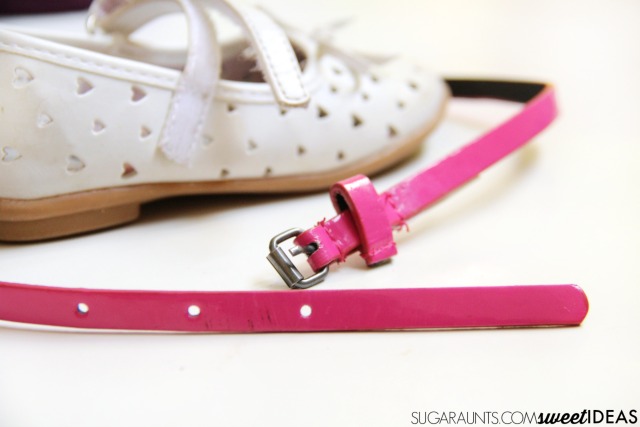
Fine Motor Manipulation Skills that are Necessary Independent Dressing
- Extrinsic Muscle Strength: The extrinsic muscles move the fingers and thumb in full flexion and extension. They enable a power grasp on functional items. The extrinsic muscles are essential for cohesive work alongside the intrinsic muscles of the hands during dynamic grasp patterns.
- Intrinsic Muscle Strength: The intrinsics allow us to use graded movements, shape the arches of the hands, and enable dexterity and precision. They control the flexion and extension of the Metacarpophalandeal joints and power movements such as finger adduction, finger abduction, thumb abduction, thumb adduction, thumb flexion and thumb opposition.
- Prehension: There are three types of prehension grasps-static grips, gravity dependent grips, and dynamic grips.
- In-Hand Manipulation: This fine motor skill typically develops around two years of age. Between 2-3 the child progresses in palm-finger translation and shift. However, at this age, they may prefer to manipulate objects between two hands instead of within one. Read more about in-hand manipulation skills here.
- Hand Preference and Bilateral Control: From the age of 2-3, a child will switch hands to avoid crossing the midline, They may show use of a preferred hand, but it may switch between activities.
- Eye-Hand Coordination: Eye-Hand Coordination is accuracy of reach and control of the arm in space, guided by vision. During dressing tasks or any functional skill, the reach should be accurate and controlled, and directed by the shoulder’s stability and mobility. In reaching for items, the hands and eyes should work together with smooth visual tracking of the hand and with the eyes guiding the hand.
- Precision of Release: There should not be immature releasing patterns noted during dressing tasks. These might include flinging or dropping objects. Rather, the child should be able to release items while their arm is positioned in space and with controlled motions. Read more about precision of release.
- Motor Planning: During functional tasks, there should be coordinated movements with appropriate positioning and posturing. Read more about motor planning here.
- Separation of the Two Sides of the Hand: Separation of the two sides of the hand allows for stability and power with precision of the thumb, pointer finger, and middle finger.
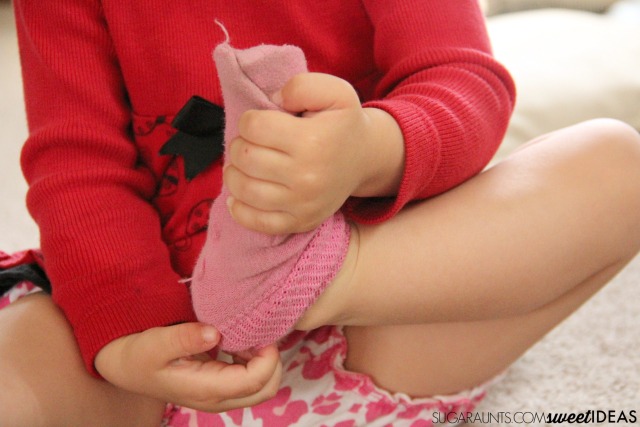
Biomechanical Postural Control in self-dressing
- Postural Control– Proximal to the arm is the upper body. Postural instability will effect the use of the forearm, wrist, hand, and fingers and complicate the motor planning and use of the hands in functional reach. When we reach with two hands, we shift our weight and move our body’s center of gravity. Without dynamic control of one’s posture, shifts in weight will result in over or under reach of distal motions.
- Shoulder stability with motion– Fine motor use of the hands requires stability of the shoulder joint. The joint needs to maintain stability even during motion and in all planes for controlled arm positioning.
- Control of the forearm– The arm between the elbow and wrist moves in supinated and pronated motions. Supination is essential for many precision tasks and allows us to see what our fingers are doing in tool or fastener use. Pronation is typically used for power grasps and hook grasps in functional tasks.
- Wrist Position– A functional wrist position is essential for precision grasp and manipulation. Extension of the wrist controls the length of the finger flexor muscles to an optimal position for grasp and precision. Positioning the wrist in 40 degrees of wrist extension allows for efficient muscle function. The wrist also moves with radial and ulnar deviation. A position of 15 degrees of ulnar deviation promotes stability and force in the ulnar side of the hand.
- Palmer Arches- While palmer arch development is a component of fine motor skill development in itself, it is also a proximal stability source for precision of the distal fingers. Appropriate arch development provides positioning and stability to allow for fine motor dexterity of the fingers.
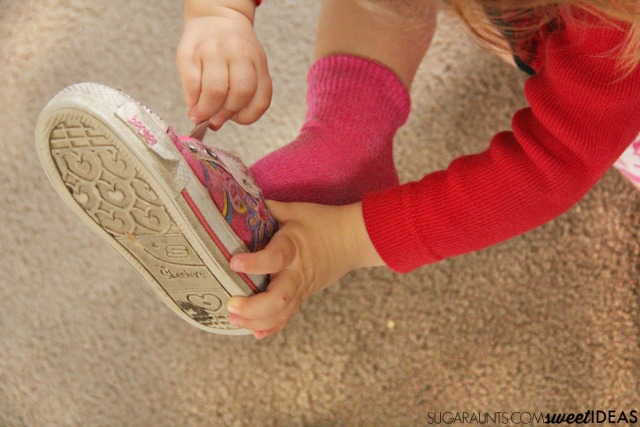
Tips to Promote Independence in Dressing Skills
- Dressing practice happens at the beginning and end of the day but there are many opportunities for working on the fine motor skills needed in dressing tasks.
- Donning shoes and socks can happen before going outdoors and when coming into the home.
- Toileting is a way to practice lower body clothing management throughout the day.
- Children can further build independence with dressing through pretend play by using dress-up clothes.
- Repetition can be a strategy for increasing opportunities for practice.
- Provide various dress-up clothes in different social roles for many ways to practice dressing skills.
- Encourage role play as a technique to build fine motor skills in dressing: Children can dress a baby doll.
- Provide alternate opportunities to practice fine motor skills needed for dressing such as toys to help kids practice dressing skills.
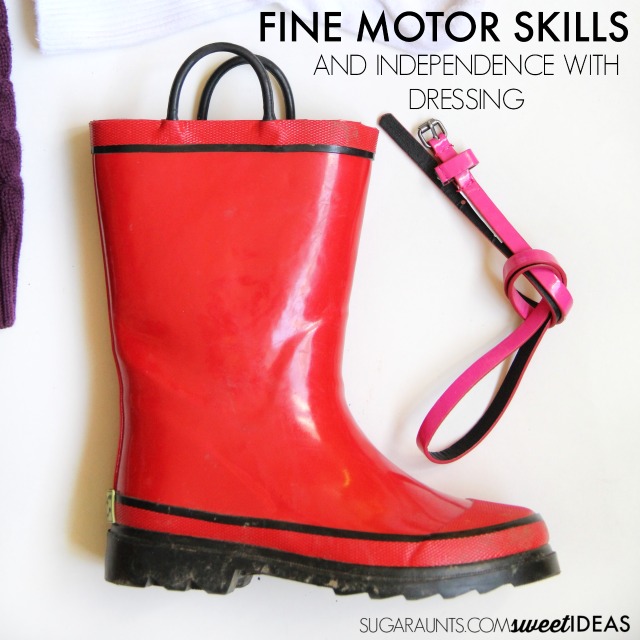

Colleen Beck, OTR/L has been an occupational therapist since 2000, working in school-based, hand therapy, outpatient peds, EI, and SNF. Colleen created The OT Toolbox to inspire therapists, teachers, and parents with easy and fun tools to help children thrive. Read her story about going from an OT making $3/hour (after paying for kids’ childcare) to a full-time OT resource creator for millions of readers. Want to collaborate? Send an email to contact@theottoolbox.com.


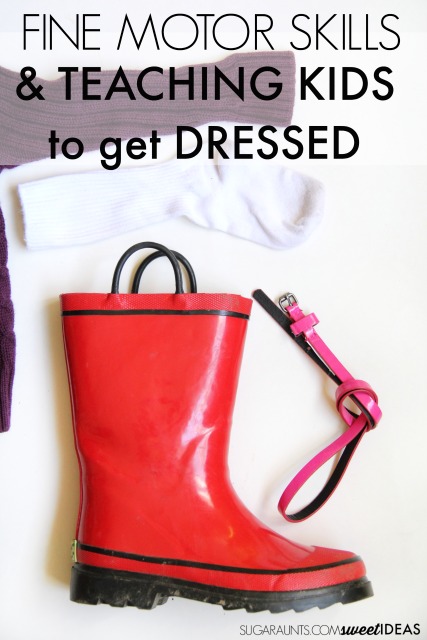





2 thoughts on “Independence with Dressing Skills”
Hello, yes this paragraph is genuinely pleasant and I have learned lot of things from it regarding blogging.
thanks.
Comments are closed.